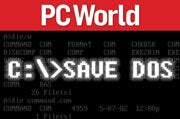
Selasa, 1 April 2008
More than a year after the release of Microsoft's Windows Vista operating system, many users continue to spurn it, citing performance problems, compatibility issues, interface annoyances, steep upgrade costs, and general bloated excess.
The growing demand among consumers and business professionals for a leaner, meaner OS has made one thing clear to PC World: It's time to bring back DOS.
Yes, DOS--the operating system that hit the market with the first IBM PC in 1981, and powered the majority of the world's personal computers until the current fad for Windows began in the 1990s.

To deny the world's computer users access to DOS is to deny them a familiar, powerful, and affordable operating system. But that's precisely what Microsoft did when it discontinued sales of MS-DOS on November 1, 2001--foisting Windows onto corporate and home users alike, whether they wanted it or not. It isn't too late to right that wrong.
We hereby urge Microsoft to reinstate sales and support of DOS 6.22 immediately. The site for our Save DOS campaign, live at SaveDOS.com, includes a slide show of great moments in DOS history, video coverage of the DOS resurgence, a history of DOS's accomplishments to date, and a community for DOS disciples to share their opinions, memories, and most-loved batch files with one another.
DOS Is Still Boss
The benefits that DOS provides over Vista--and even over the relatively reliable and (admittedly) widely supported Windows XP--are as varied as they are undeniable.
For instance, for power users who require maximum efficiency on today's hardware and find overwrought graphical interfaces useless, DOS is the ultimate high-performance OS. (Check out our DOS vs. Vista features-comparison and performance-testing charts for more details.)
For high-end gaming, DOS takes a radical approach to supporting serious performance by placing minimal demands on system hardware, leaving the PC's memory and processor cycles free to render mind-blowing 256-color graphics.
Security, a major bugaboo for Windows users, is a nonissue with DOS, since hackers stopped writing DOS viruses years ago and every known piece of spyware in the wild is incompatible with the operating system. Another plus: The lack of graphical browsers for DOS completely eliminates Web annoyances such as pesky pop-up ads.

Even mundane tasks, such as displaying the contents of a directory, are quicker with DOS. Want to find and open a folder? In Windows, you must put your mousing wrist at risk of repetitive stress injury with several time-wasting mouse clicks. In DOS, all you have to do is type dir c:\foldername /p--engaging both of your hands (and therefore both hemispheres of your brain) and touching the same key twice in only three instances.
Yet another benefit: DOS vastly simplifies the tedious and complicated process of installing and removing software, which in Windows tends to choke system resources. Whereas Windows programs frequently leave miscellaneous files and configuration settings strewn around your PC, nearly all DOS apps uninstall completely when you delete the program's directory, leaving your PC with the digital equivalent of a freshly vacuumed carpet. In that regard, DOS offered Mac-like simplicity years before Apple ever thought of it. (Come to think of it, that makes DOS a viable upgrade path for disgruntled OS X "Leopard" users, too, since today's Intel-based Macs are, at their hearts, powerful and stylish DOS boxes.)
DOS vs. Vista: No Contest
Unlike Windows Vista, DOS doesn't waste precious resources displaying unnecessary eye candy. In fact, most versions--from IBM's PC-DOS to Microsoft's MS-DOS to newer open-source variants such as FreeDOS--can run extremely well with a few hundred kilobytes of RAM and less than 10MB of hard-drive space. That frees the rest of your PC's disk space and RAM to perform more-important tasks.
Windows Vista, of course, requires a minimum of a 1-GHz processor, 512MB of RAM, and a DirectX 9 graphics card just to boot the OS. To handle all of the operating system's baroque flourishes, users need 1GB of RAM and a discrete graphics card armed with more than 128MB of video memory.
DOS could hardly be more different.
As you can see in the accompanying chart (click the thumbnail at left to view the full-size image), DOS's full complement of user-friendly features handily beats Windows Vista's complex set of tools. Feature for feature, DOS offers a simpler, more efficient way to accomplish your computing tasks.
In today's world, highly mobile world, Vista's demanding specs leave many laptops--even relatively new models--out in the cold. DOS, however, can turn an aging laptop into a performance powerhouse faster than you can say "Where do I want to go today?"
In our tests, DOS outperformed Windows Vista in every task we threw at it, as shown in the second accompanying chart (click the thumbnail at right to view). From its astonishingly brisk boot times to its snappy shutdowns, DOS does everything faster and less fussily. As for the things it can't do at all, well, none of them actually matter.
Hey, What About Windows XP?
Despite cries of outrage from sober, diligent, and thrifty users, Microsoft says that it intends to stick with its plan to end most sales of Windows XP on June 30, 2008, effectively steamrolling (or stampeding, depending on the visual that captures one's fancy) consumers into adopting Windows Vista from that point forward, willy-nilly.

Sensing the burgeoning wave of dissatisfaction with Vista, our colleagues at InfoWorld earlier this year initiated a Save Windows XP campaign. More than 100,000 users have signed an InfoWorld petition addressed to Microsoft so far.
InfoWorld argues that, with its smaller footprint, simpler interface, and lower system requirements, Windows XP has numerous and substantial advantages over Vista. We concur. But taking the same reasoning even further, we believe that a DOS revival would solve even more problems associated with Windows-era gewgaws and fripperies--thereby essentially eliminating the need for continued XP sales into the bargain.









